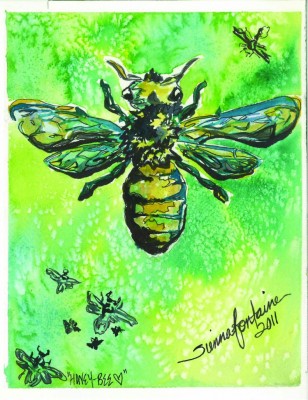The Importance of Bees to our Food Supply

Bees, particularly honeybees, have been around for millions of years and are responsible for pollinating over a third of our food supply and 90% of wild plants. Pollination is key in the reproduction of many plants. The honey bee is a major pollinator of several of our food crops including almonds, apples, avocados, cherries, cranberries, sunflowers, watermelon and many more. The honey bee is so essential in crop pollination that some farmers “rent” them or ship them in to pollinate their crops in the spring. But the bees significance goes far beyond crop growing. They also pollinate more than 16 percent of flowering plant species that make our garden beautiful, and of course, there is also honey. More than $130 million worth of raw honey was produced in 2002 in the United States (USDA).
Colony Collapse Disorder (CCD) is the name given to the most serious die-off of honey bee colonies in decades. Over 25% of managed honey bee populations in the U.S. have disappeared since 1990.
CCD is characterized by the abrupt and mysterious disappearance of all adult honey bees in a hive. A few young bees and perhaps the queen may remain, or there may be no bees left. Honey and pollen are usually present, and there is often evidence of recent brood rearing (the process involving egg laying, feeding larvae, and keeping pupae warm which produces more adult bees). This sudden evacuation is very abnormal, because bees are not prone to depart a hive if there is brood present. If honey bees disappear or continue to die in rapid numbers our food supply will decrease in supply and increase in price.
No cause has been attributed to CCD yet but research suggests one or more of these theories are to blame:
Chemicals
Some believe that the heightened use of chemicals such as pesticides and herbicides (that honeybees ingest during pollination) are largely to blame. Another potential suspect is genetically modified crops (GMOs), which may produce pollen with compromised nutritional value. It may be that the increase of chemicals and GMO pollen has reached the breaking point, stressing bee populations and causing this collapse. One sign that this may be true is organic bee colonies, where neither chemicals nor GMOs are used crops, are not experiencing the same kind of disastrous collapses.
Climate Change
Biologists are studying if global warming may be having an affects on the growth rates of pathogens (i.e. viruses and fungi) that are know to destroy bee colonies. The abnormal hot-and-cold winter weather patterns in recent years may be to blame for bee population collapse because they’re accustomed to more consistent weather patterns.
Radiation or the Cell Phone Tower Theory
Bee populations are also susceptible to the recent increase in atmospheric radiation due to a heightened number of cell phones and wireless communication towers. The increased radiation given off by the towers may hinder bees navigation skills. A small study at Germany’s Landau University found that bees would not return to their hives when mobile phones were placed in the area.
As Scientists continue to search for the cause there are some things we can do to help.
Buying organic is a great way to help this unfortunate situation since pesticides kill bees too. Secondly you can make a bee haven by growing the plants bees love. These include bee balm, sunflowers, every kind of herb (including thyme and oregano) and any kind of Mint (you can find more suggestions here).
If you would like to read further about this topic, here are some resources:
http://www.ars.usda.gov/is/ar/archive/mar04/form0304.pdf
http://www.edf.org/sites/default/files/edf-solutions-2012-summer.pdf#page=12
http://www.epa.gov/opp00001/about/intheworks/honeybee.htm
http://www.nrdc.org/wildlife/animals/files/bees.pdf
http://www.onearth.org/article/the-latest-buzz-on-bees
~Amy
Intern Extraordinaire



